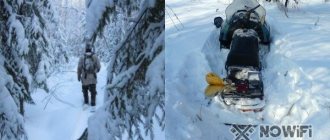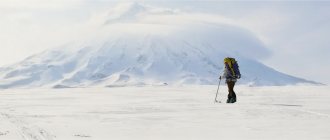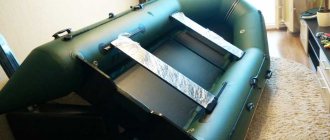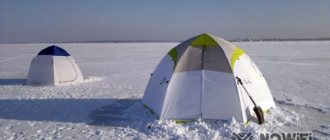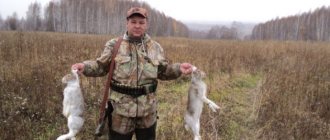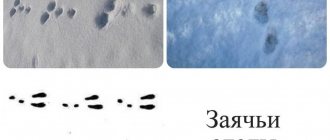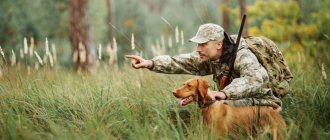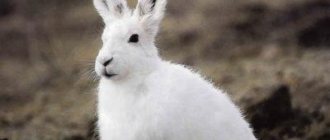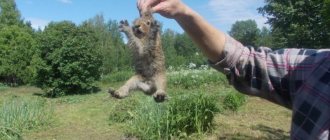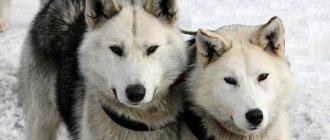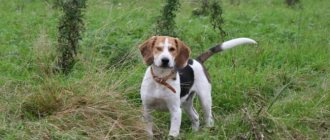It was customary to hunt hares in our area back in ancient times, because these animals are extremely common in many regions, regardless of climatic conditions. In most cases, you don’t even need a permit to hunt a hare, because the population of these animals is large and rarely drops to a critical level.
It should be borne in mind that, despite the popularity of such active recreation, it will not be so easy to get game, because hares are distinguished by amazing speed and caution, so it is extremely difficult to get close to them unnoticed. However, armed with certain theoretical knowledge and developing the necessary skills, you will be able to get the desired trophy.
- Equipment
- Trailing
Hare hunting in winter
When planning to go hare hunting in winter, you should be prepared for the fact that getting a trophy will not at all be like a pleasure walk through a snow-covered forest. First of all, you will have to track down the animal’s habitat, and then spend long hours in ambush. Only if these conditions are met will you be able to shoot your prey.
Experienced hunters recommend going hunting with dogs, because these animals make hunting much more productive. However, if you do not have such an assistant, you can easily cope on your own. Naturally, for this, it is advisable to study in advance the habits of the animal and the types of hunting for it, as well as learn to determine the habitats of the killer whales.
Grouse hunting in winter
Usually in winter, black grouse hunting is practiced on holes, because these birds prefer to wait out the cold under the snow. Despite the fact that this method is considered one of the simplest, it still requires certain skills.
Firstly, the hunter must be able to locate holes - holes in the snow in which birds live. Secondly, you need to learn to determine which hole is inhabited and which game has left long ago. Thirdly, the hunter must be able to move silently and unnoticed, so as not to prematurely scare away the prey. And, naturally, it is advisable to study the habits of the bird in advance and practice marksmanship, since the success of the entire fishery will depend on this. It is these nuances that we will consider in more detail in the following sections.
Description and characteristic features of the beast
The main feature of Russians is that they have extremely fine hearing, but their eyesight is very poor. Accordingly, the animal first hears the enemy, and only then notices him visually, but this does not at all prevent him from immediately fleeing in case of danger.
Note: Orcas have very well developed hind limbs, which allow them to develop surprisingly high speeds. In extreme cases, the hare can inflict deep, jagged cuts with these same limbs to weaken the enemy.
The family of wild hares includes many breeds, or rather subspecies, and they differ in many ways not only from domestic rabbits, but also from wild rabbits. Firstly, hares have much longer ears. Secondly, depending on the season, they change coat color, while rabbits do not shed (Figure 1).
In our country, such breeds of wild hares as hare, hare, tolai and Manchurian hare have become widespread, although there are about 30 species of these animals all over the world. They prefer to live alone, in burrows and various cavities. Females cannot be called good mothers - already a week after the birth of the cubs, she abandons her offspring forever, so young individuals often become prey to hunters or predators.
You should look in more detail at the habitats of hares:
- From the European part of Russia to the Middle East, white hare can be found everywhere, preferring to settle in the forest-steppe zone. The weight of such an individual can reach 4.5 kg with a body length of 50 cm.
- In the open areas of the European part of the country, there are hares, which are slightly larger than hare: their body length is approximately 65 cm, and their weight is about 7 kg. Unlike white hare, these animals never turn white, and their coat only lightens slightly during the winter.
- Tolay is similar in appearance to a hare, but its habitat is limited to Transbaikalia and Southern Siberia.
- The Manchurian breed is found exclusively in the Far East, and it is these hares that most closely resemble ordinary rabbits in appearance.
Figure 1. Main breeds: 1 - hare, 2 - hare, 3 - tolai, 4 - Manchurian
Having studied the main features and regions of residence of these animals, we can conclude that you can hunt animals in almost any region and at any time of the year.
Hare behavior in winter
In winter, hares do not hibernate, but continue to live in burrows and look for food under the snow (Figure 2). This feature makes winter hunting for them effective and efficient, and in some cases even like an exciting game.
Figure 2. In winter, hares lead a separate lifestyle
The best weather for going into the forest for a trophy is the time when the first snow falls, because the traces of an animal that has left its bed in search of food are clearly visible on it. Naturally, you can try to follow the animal's trail, but in most cases such an idea will lead to nothing: hares can reach speeds of up to 60 kilometers per hour, so you won't be able to catch up with them.
It is much more effective to find the animal’s habitat, set an ambush and wait for the time when the animal may appear. At the same time, it is important to behave very quietly, since the slightest rustle or noise can scare away the game. It is important to ambush against the wind, as hares usually sit downwind so that the air does not blow against their fur. By positioning yourself in this way, you will protect yourself from a situation where the animal senses you before you fire the first shot.
Features of winter hunting
Winter hare hunting, due to weather conditions, has certain features. First of all, you need to take care of your equipment, since getting a trophy involves not only constant movement through the forest, but also sitting in ambush for a long time.
Note: Clothing must be selected depending on weather conditions. For example, in the rain you will need a waterproof jacket, but it is better to travel long distances in the snow on a snowmobile. However, it should be taken into account that you will still have to walk to the animals’ habitat so that the noise of traffic and the smell of gasoline does not scare off the prey.
The importance of proper equipment is well known to hunters who hunt in Siberia. They can go into the forest for several days at once, so the equipment should include not only warm, waterproof clothing and shoes, but also a minimum set of food and water, a first aid kit, a thermos and a flashlight. If you have never hunted such a trophy before, the tips in the following sections will help you properly prepare for the hunt.
When and where is the best time to hunt?
In order for winter hare hunting to be truly successful, it is better to conduct reconnaissance in advance and determine the habitat or feeding areas of the animals. In the future, you can simply drive up to the desired location by car, select a location for an ambush and wait for the right time to shoot (Figure 3).
There are several tips for successfully hunting hare in the tundra or other hare:
- You need to shoot at the animal itself, and not at its shadow, which is always darker than the main silhouette.
- It is advisable to place the ambush shelter in such a way that it is located directly opposite the hare's path. In this case, the shadow of the animal will not prevent you from making a successful shot.
- If you have to shoot an animal in the back, it is better to aim for its upper body. However, this condition is relevant only if the animal has not begun to flee. If you need to shoot a running hare, it is best to shoot at the tips of its ears.
- The best time for hunting is early in the morning, or even better - dawn. At this time, the animals crawl out of their hiding places and, without feeling any sense of danger, go to feed.
Figure 3. The extraction of a trophy largely depends on the right place for fishing and shooting accuracy.
When going to the forest, take an interest in the weather forecast in advance. For example, during heavy snowfall, animals become more cautious, and hitting game in a snowstorm will be very problematic. If heavy snowfall still finds you fishing, the best way to look for game is to plow. The rest of the time you can meet hares in ordinary open fields.
Game allowed to be shot in winter
In winter, the following are allowed to be shot: hare, elk, deer, roe deer, wild boar.
Not all birds fly to warmer climes for the winter; many remain here in the forests. These are: capercaillie, black grouse, pheasant, partridge, hazel grouse.
Hare hunting in winter
Hunting for hare in winter begins immediately after the first snow falls. On the snow-white cover, traces of a hare are clearly visible, which recently left its bed in search of food. Of course, you can try to follow the animal's trail, but most likely this will lead to nothing, because the hare reaches speeds of up to 60 km/h. It's almost impossible to catch up with him.
A much more effective method is to find the hare’s habitat. That's where you need to set up an ambush. It is important to be quiet; hares have excellent hearing and are very easy to scare away. Set up an ambush against the wind, since hares usually sit downwind.
Types of winter hare hunting:
- Trapping. The most exciting type of fishing. Finding a hare's tracks is not an easy task, so if you are a novice hunter, enlist the help of a more experienced tracker.
- Out of hiding. This method is more suitable for late winter. At this time, it is already more difficult for hares to find food and they are getting closer to human settlements.
- With a dog. Hunting hares with hounds is the most popular method. Dogs are good trackers and quickly find animals.
- From the approach. An equally popular method requires suitable weather: wet and windless.
Moose hunting in winter
Winter elk hunting is more than just a game. This is an exciting and very exciting pastime. When hunting for elk, the hunter has a chance to demonstrate all his skills, because getting it is not so easy. If you are successful, the reward will be the coveted trophy and the respect of the hunters' friends.
Ways to hunt elk in winter:
- From the approach. The hunter needs to find the elk and get within shooting distance.
- Stealth. The best time for this method is a clear, frosty and slightly windy day.
- Corral. Collective and the most unsafe type of fishing. When in danger, an elk can behave unpredictably and aggressively.
- With dogs. Husky hunting in winter is a popular type of elk hunting. Two or three trained dogs will be enough. It is important to know that it is better not to take a husky without hunting experience for an elk; the dog can receive serious injuries.
Roe deer hunting in winter
Winter roe deer hunting is characterized by its own characteristics. During the harsh season, the behavior of a roe deer creates additional difficulties for the hunter. First you need to determine where the animal feeds. Usually these are edges and forest clearings. Roe deer are shy, so they feed at dusk and at night, but in severe winter conditions, they can be seen during the day.
Many winter hunting enthusiasts prefer roe deer hunting from a tower. This is an effective method, the main thing is to place the tower correctly. The best place is the edge of a forest or clearing.
Wild boar hunting in winter
The boar is a dangerous, strong animal. This is both the difficulty and the interest of hunting this animal. It is important for the hunter to observe the following precautions:
- Provide shelter. It could be a boulder, a wide stump or a tree. Cover must be found before preparing to shoot. It may be needed if the boar notices you earlier and decides to attack.
- Correctly determine the location of the shot. A wounded boar is very dangerous, so it is important to fire one precise shot: in the side, under the shoulder blade or along the ridge.
- The pursuit. You should not follow a wounded animal. He will go deep into the forest, and if he sees a hunter, he will immediately attack. Never approach a boar from the front.
Hunting wild boar from a tower in winter is considered one of the popular and safe methods. On the tower, it is important to behave quietly so as not to frighten the animal; all that remains is to make the right well-aimed shot, which will allow you to get the coveted trophy.
Grouse hunting in winter
Hunting for grouse in winter is one of the most exciting activities. This type of hunting requires the hunter to have a quick reaction, endurance, attentiveness and, of course, accuracy. This is an invaluable experience and a great test of your hunting skills.
By the beginning of winter, black grouse gather in flocks. The bird does not like the cold, so during severe frosts it spends hiding in the snow - the very holes that the hunter needs to find.
It is better to start hunting grouse on holes in slightly windy and frosty weather (from -10 to -20 degrees). First, the hunter needs to find holes with birds, then approach unnoticed and only then shoot at the flying birds. You may need binoculars to locate the holes, so the search will go faster. Daylight hours in winter are short, so it is better to comb the area in advance to find the habitats of grouse.
Varieties of winter hare hunting
Many people think that winter hare hunting comes down only to the fact that the hunter constantly walks through the forest, hoping to find a trace of the animal or the animal itself. In fact, the movement of hunters through the forest has a certain logic, because they are not just looking for traces of hares, but also their supposed habitats or feeding places.
There are quite a lot of types of hunting, and each of them has its own characteristics and rules, following which you can get a trophy without much difficulty. Next, we will look at their main features so that novice hunters can choose the preferred method of hunting game.
Trailing
Hare hunting by tracking is considered one of the most exciting types of hunting. The essence of this method comes down to correctly reading and deciphering animal tracks. Accordingly, the key role in this case is played not so much by the selection of the right weapon, but by the hunter’s endurance, his ingenuity and the skills of a tracker (Figure 5).
Note: Hares are very good at confusing their tracks, so when going trail hunting for the first time, it is better to take a more experienced hunter with you who will help you read the tracks correctly.
Hunting by tracking is carried out only if snow has recently fallen. This will make the task much easier, since you will not get confused in the tracks previously left by the animal. As a rule, during the daytime, hares rest in their burrow and only in the late afternoon come out to feed, leaving footprints in the snow. You can use them to track the animal.
Figure 5. You can track an animal by its tracks
Since hares like to run around after eating and further confuse their tracks, it is better to immediately follow the path of tracks and find the animal’s burrow, wait for its appearance and make an accurate aimed shot. It is difficult to track the animal using circular tracks, and only an experienced fisherman can cope with this task.
Out of hiding
If the snow layer is small, or you go hunting at the end of winter, when the snow cover begins to melt, the best option for obtaining a trophy would be to hunt a hare from ambush. In addition, at the end of winter it is already very difficult for animals to find food and, despite their caution, they come closer to human habitation (Figure 6).
Since this type of hunting involves waiting for the animal to appear, you will have to build a shelter:
- Build a structure similar to a snowdrift from compressed blocks of snow.
- You can use a white tent, which will not stand out in the area.
- If there is a stack of straw or selenium nearby that is not too frozen, you can use that too.
The most advantageous shelter is considered to be a haystack, since hares, in search of food, often get very close to them. If you set up cover here, you will have a much better chance of shooting game. That is why this type of hunting is most often recommended for beginning hunters.
Figure 6. The location for the ambush must be chosen very carefully.
If you don’t have the opportunity to build a permanent shelter, you can easily put on a camouflage robe and sit on an ordinary folding chair. However, it is better to take a position from the side of the hare path, so that it is more convenient to aim at the animal, and the prey does not smell you ahead of time.
In addition to the proper organization of the hiding place, you should also take into account the habits of the animal itself. Remember that hares are predominantly nocturnal: they spend the day in a hole, and in the evening they begin to emerge from the shelter in search of food. Therefore, it is better to set up an ambush in the evening or even at night.
Note: Many people worry that it will be difficult to hit the animal in the dark. In fact, in moonlight, reflected from even a minimal amount of light, a hare can be seen just as well as during the day.
There is a secret that all experienced hunters use. They divide the hare hunt into three nights: on the first night they look for and read the tracks, on the second they check the feeding area, and on the third they actually hunt. In addition, you can place bait in the feeding area, which will help attract more animals and increase the chances of getting a trophy.
With a dog
Hare hunting in winter with hounds is also very popular. The fact is that these dogs know the tracks of animals very well and can quickly lead the hunter to the prey (Figure 7).
Note: Running away from the dog, the hare makes a circle and still returns to its original place. Therefore, the hunter can only wait for the animal to return and make a well-aimed shot.
Figure 7. Dogs will help track and catch up with game
Naturally, for hare hunting with a dog to be effective, the assistant must be properly trained. Fortunately, training for hare hunting is not difficult. The most important thing is to teach the dog not to be distracted by other animals, for example, by a fox, which may come into the hound’s field of view while hunting a hare. In addition, hunting with a husky involves rewarding the animal: be sure to let the dog taste the taste of hare meat. This way she will have an incentive to catch up with the animal and will not lose interest in hunting.
With loops
There are quite effective ways to hunt a hare without a dog. One of the most effective is using loops. They can be installed either as an independent structure or in combination with traps or other fishing devices (Figure 8).
Note: Please note that this fishing method is not permitted in all regions, so be sure to check local legislation before heading into the forest.
Catching a hare with loops has certain features:
- It is advisable to tie the trap to a thin and flexible tree so that the animal, once caught in the loop, cannot escape.
- If the loop is equipped with a lift, it is desirable that the animal suffocate quickly: then it will not tear the structure.
- It is better to place the loop in such a way that the hare gets into it with his head. Based on this, experienced fishermen recommend installing traps over a fallen tree.
- To guarantee a trophy, it is advisable to install structures directly on hare trails. They are very visible in winter, as the animals usually run along the same route.
Figure 8. Diagram for making and installing a loop yourself.
It is also important to consider that the loop should be almost invisible. To make it, it is better to use thin wire: it does not stand out in the surrounding landscape, but at the same time is quite strong. Immediately before installation, be sure to wipe the wire with any fragrant herb growing in the forest to eliminate the metallic smell.
From the approach
Hunting a hare in winter from the approach is the most common way of catching this game. But at the same time, fishing will be successful only if the weather outside is windless and with high humidity. In the summer, such weather promotes almost silent movement through the forest, and in the winter it helps to track down the hare spending time in a hole (Figure 9).
Figure 9. Hunting from the approach involves studying the habits of the animal
Despite the popularity of this method, you should be prepared for a sudden shot, especially in an open space, because the game can get scared and jump out of its cover at any moment.
With traps
Traps can also help catch a hare, but this method of catching is not in great demand among hunters who prefer to catch game in more interesting ways. However, this method should still be considered, since it is often used in regions where catching hares with snares is prohibited.
They begin setting traps immediately after the first snow falls, and it is advisable to use traps with large numbers. This is due to the fact that hares have very strong paws. However, it should be taken into account that the trap should not have a spring that is too tight, which could break the animal’s limb (Figure 10).
Note: As a rule, hunters install pressure and walk-through traps, but you should be prepared in advance for the fact that after them you will have to spend a lot of time masking traces.
Like loops, it is advisable to treat traps. For example, in the forest they can be rubbed with pine needles, and in the field with wormwood, but even without such camouflage, hares are unlikely to pay attention to the metallic smell.
In order for the prey to be accurately caught in the trap, the trap must be installed correctly:
- Selecting a location: It is advisable to set traps after snow has fallen. Traces of the animals will be clearly visible on its surface, and you will be able to easily determine the place of their feeding. This is where one or more traps should be placed.
- Trail traps: usually set along the trail of a hare at the turn of the path along which the animals follow to the feeding area after leaving the holes. This way, the likelihood of the animal falling into a trap will be much higher.
- Camouflage: To prevent the hare from noticing the structure, you need to carefully cut out a layer of snow, set a trap and return the snow to its place.
- Bait: selected depending on the breed that is most often found in a certain region. For example, white hare loves to eat aspen, especially the one that has been lying around for a while. You can also use birch or rowan branches covered with oats or snow. Browns love hay and straw more, and feast on branches mainly at the end of winter. You can use any vegetables as bait, or pour a weak saline solution over the bait.
Figure 10. Design of a trap
When installing a trap, be sure to keep in mind that white hares are much more careful than brown hares, and it will be more difficult to catch them. In addition, it is necessary to take into account that with a sufficient amount of natural food, hares are unlikely to go out into the open space, therefore it is better to place traps where animals are more often found.
Winter grouse hunting
Grouse hunting in winter is exciting and exciting. This upland game is most often caught from a hole where it burrows for a daytime rest. After all, it’s cold in winter, but it’s much warmer under the snow. Only people who are quick to react can catch a snorting grouse. This bird can be found in the forests of northern and central Russia, in Siberia.
In winter, it feeds on plant food, in particular pine needles, buds and catkins of birch, and stays on the edges of the forest, near swamps. This bird does not like frosts. In such weather, she does not leave the snow shelter at all and does without feeding. She has adapted to the harsh winter conditions.
It’s warm in its hole, and this feathered inhabitant can survive without food for several days. They rest in the snow and digest their food. By morning, the hole is full of droppings, and the birds noisily crawl out of the snow. After feeding, they fall back into the hole and rest there for up to twenty-two hours a day.
The hunter looks for clusters of black grouse and tries not to frighten away the birds, which have good sense of smell and hearing. These birds see poorly, so a camouflage suit is not necessary. The main thing is to walk through the forest in complete silence, so the suit should not rustle. They go hunting until dawn.
First, you can illuminate the path with a flashlight, then turn off this device. They do not take the dog with them, since its help is not needed on such a hunt. The hunter constantly looks through binoculars. He tries to detect holes by barely noticeable signs.
You need to find a hillock and approach it at a distance of thirty meters, so that the birds do not hear and fly into the trees earlier than necessary. In the dark, you can make a mistake, mistaking an ordinary bump for a hole. But nevertheless, you should be as calm as possible, the ski step should be measured.
Feathers scattered on the snow will help you find winter shelters for grouse.
If there is a lot of droppings, fluff and feathers on the snow, this means that the birds have already flown out. But if you manage to get to the place before dawn, the black grouse will still be in the holes. These birds are masters of camouflage, taking great care to disguise their presence in the snow. Next, you should apply the following tactics.
After accurately detecting a hole with a grouse inside, you should approach the hole at a distance of three meters and noisily hit the snow with a ski pole or branch. The black grouse will fly out and needs to be shot down during the flight. Snow dust raised by bird wings can prevent you from making an accurate shot.
It is the male that must be killed; the female must not be touched. The male is always at the edges. A grouse left alive in the spring can still become a mother for a large number of grouse cubs. You should aim at a specific bird, and not shoot at a flock if several birds fly out at once.
They also go after black grouse resting in a hole in the evening. In winter it gets dark early and therefore you will also have to wander with a flashlight in your hands. Black grouse often stay in holes near birch groves, as they prefer to feed on birch catkins and buds.
In winter, they are released at intervals in time, so the shots will be more meaningful and therefore there is a higher chance of accuracy. A wounded animal should always be killed, otherwise it will die anyway and become dinner for a fox or a hungry wolf. On an evening hunt in winter, an average of two or three birds are caught, which will go into a delicious soup.
Rules for searching for game
Experienced hunters recommend not going into the forest blindly, but following certain rules for searching for game. First of all, it should be taken into account that animals constantly change their places of lying and feeding. The choice of such a location is influenced by the weather: when it is damp outside, animals prefer to settle on high ground, and in dry weather - in lowlands.
Of course, the easiest way to search for game is with dogs, which can smell and scare away a hare. But it is better to go for such a fishery in the first snow. The alarmed animal will run around its bed, and the hunter will have the opportunity to make an accurate shot.
Tips on how to untangle hare tracks
Finding the trail of a hare in the forest is not a problem, but deciphering it correctly can cause certain difficulties. The fact is that hares are extremely cunning animals and leave so many traces of their presence that an inexperienced hunter can easily get confused in them (Figure 11).
To properly navigate the hare trails, follow these tips:
- Try to walk not along the footprint itself, but next to it, so as not to accidentally step on the paw marks.
- Keep an eye not only on the snow, but also periodically look up to the horizon. Confusing its tracks, the hare often makes a circle and returns to its previous place to make itself a bed.
- Look not only at the trail, but also at the surrounding area, especially at places that can provide good cover: thick bushes, snowdrifts or hillocks.
- If you find a spot of fat, do not try to untangle a huge number of traces. Just walk around the location, find a single trail that comes out and follow it.
Figure 11. Deciphering hare tracks
If at any point you find twos, threes and discounts, slow down and take a closer look at your surroundings. Such tracks mean that the hare’s resting place is already nearby and you can scare it away at any moment.
How to shoot an animal correctly
Hares are very fast animals, so you should be prepared for an unexpected shot. In addition, you may not have enough time to aim well, so it is best to familiarize yourself with the tips that will determine successful shooting in advance.
Firstly, you need to remember that the silhouette of the animal itself is always lighter than its shadow, so you need to aim at a lighter place in the snow. Secondly, when shooting from possible cover, it is better to position yourself so that the trail of the hare's trail goes towards your ambush. Then the shadow will interfere with a well-aimed shot.
In addition, you need to know which part of the body to aim for. If you come to a distance sufficient to shoot, it is better to aim at the upper part of the body, and if the animal starts to run away, then it is better to shoot at the tips of its ears. If a situation arises in which an animal runs straight at you, aim for its front paws.
Recommendations from experienced hunters
In order for the hunting of an animal to be successful, it is necessary to take into account the advice of experienced hunters. First of all, when going fishing, take into account the weather conditions. Calm weather with temperatures just below zero is ideal. It is also advisable to go into the forest on freshly fallen snow, on which the animal’s footprint will be better visible.
In addition, study the habits, types of tracks and habits of the animal in advance. This way you will have a better chance of finding prey without walking through the forest for a long time. If you are interested in the secrets of successful hare hunting, we recommend watching a video that outlines the main nuances of this hunt.
So when can you hunt in winter?
There are only three hunting seasons in our country. The spring hunting season is the shortest, lasting only ten days, but the summer-autumn hunting season is long, lasting more than three months. The winter hunting season begins on the first of December and lasts until the New Year.
It must be remembered that in each of these three periods hunting only certain types of animals is allowed. So in winter, hunting is allowed for wild boar, fur-bearing animals, elk, male roe deer, duck and pheasant, but it is forbidden to hunt brown bear. Beaver hunting is also allowed in winter; wolves are actively hunted during this period.
It is worth noting that despite the official opening of the hunting season, in each specific area regional authorities may introduce restrictions both on the timing and on the types of animals that can be hunted.
And most importantly, remember about the license; the Department of Hunting is responsible for issuing documents for shooting animals. It’s definitely not worth going into the forest to hunt without it.
In general, you can get a shooting license in two ways: the first is probably the simplest - by directly contacting the hunting authority or an intermediary. The method is simple, you will receive a license as quickly as possible, but the issue of cost will be several times different from that received directly from the Department of Hunting.
Therefore, if you have time, since the second method is not very fast, it is better to make a license yourself. Remember and collect all the necessary documents in advance to obtain a license, submit them to the local Game Department - this will allow you to save a good amount.
